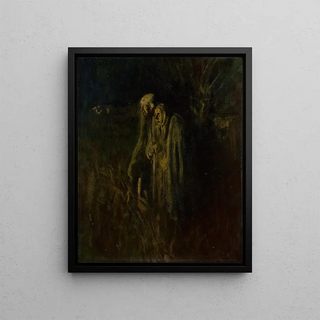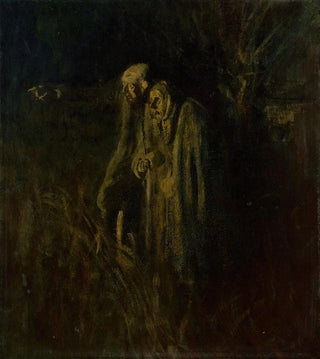Art print | Elderly couple at the end of life at night - Ladislav Mednyánszky


View from behind

Frame (optional)
In the rich and complex universe of art, some works stand out for their ability to capture deep emotions and poignant moments of life. "Couple of elderly people at the end of life at night - Ladislav Mednyánszky" is undoubtedly one of these works. It evokes the fragility of human existence and the beauty of the bonds that unite beings, even in the final moments of their lives. The nocturnal scene, imbued with melancholy, invites the viewer to an intimate reflection on the passage of time and the tenderness that can remain in the face of the inevitable. Every brushstroke seems to whisper stories of life, sharing, and love, making this work particularly touching and universal.
Style and uniqueness of the work
Mednyánszky's style is characterized by an exceptional mastery of light and shadow, creating an intimate and contemplative atmosphere. In "Couple of elderly people at the end of life at night," the artist uses dark, almost dramatic tones to evoke the night and the emotions it accompanies. The characters, although aging, exude dignity and serenity, reinforcing the idea that the end of life can be a moment of peace. The composition is carefully balanced, each element having its place in this meaningful painting. The texture of the clothing and faces is rendered with striking delicacy, allowing the viewer to feel the human warmth emanating from this scene. The singularity of this work lies in its ability to transcend the simple portrait to become a true reflection on love and mortality.
The artist and his influence
Ladislav Mednyánszky, Hungarian painter of the 19th century, is often recognized for his ability to depict everyday life with acute sensitivity. His work is marked by a deep empathy for his subjects, whether peasants, portraits, or scenes of urban life. Influenced by the Impressionist movement, Mednyánszky managed to incorporate elements of this style while preserving his own artistic vision. His interest in themes of solitude and the

Matte finish

View from behind

Frame (optional)
In the rich and complex universe of art, some works stand out for their ability to capture deep emotions and poignant moments of life. "Couple of elderly people at the end of life at night - Ladislav Mednyánszky" is undoubtedly one of these works. It evokes the fragility of human existence and the beauty of the bonds that unite beings, even in the final moments of their lives. The nocturnal scene, imbued with melancholy, invites the viewer to an intimate reflection on the passage of time and the tenderness that can remain in the face of the inevitable. Every brushstroke seems to whisper stories of life, sharing, and love, making this work particularly touching and universal.
Style and uniqueness of the work
Mednyánszky's style is characterized by an exceptional mastery of light and shadow, creating an intimate and contemplative atmosphere. In "Couple of elderly people at the end of life at night," the artist uses dark, almost dramatic tones to evoke the night and the emotions it accompanies. The characters, although aging, exude dignity and serenity, reinforcing the idea that the end of life can be a moment of peace. The composition is carefully balanced, each element having its place in this meaningful painting. The texture of the clothing and faces is rendered with striking delicacy, allowing the viewer to feel the human warmth emanating from this scene. The singularity of this work lies in its ability to transcend the simple portrait to become a true reflection on love and mortality.
The artist and his influence
Ladislav Mednyánszky, Hungarian painter of the 19th century, is often recognized for his ability to depict everyday life with acute sensitivity. His work is marked by a deep empathy for his subjects, whether peasants, portraits, or scenes of urban life. Influenced by the Impressionist movement, Mednyánszky managed to incorporate elements of this style while preserving his own artistic vision. His interest in themes of solitude and the






